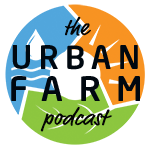393: Brad Lancaster on Wild Food Forestry.
Harvesting native foods in the Sonoran Desert.
 Brad runs a successful permaculture consulting, design, and education business. He is focused on integrated and sustainable approaches to landscape design, planning, and living. Growing up in a dryland environment, water harvesting has long been one of his specialties and a true passion.
Brad runs a successful permaculture consulting, design, and education business. He is focused on integrated and sustainable approaches to landscape design, planning, and living. Growing up in a dryland environment, water harvesting has long been one of his specialties and a true passion.
Brad is the author of a permaculture bible for water harvesting: Rainwater Harvesting for Drylands and Beyond Volumes I & II and is a contributor to Desert Harvesters’ Eat Mesquite and More cookbook. This new release centers on the abundant harvest of mesquite and other Sonoran Desert food plants we can plant, steward, and enjoy where we live, work, and play.Don’t miss an episode! Click here to sign up for podcast updates
In This Podcast:
The desert is full of amazing native plants that provide a rich, delicious bounty of food, IF you know what to look for and how to harvest it, and Brad Lancaster wants you know these secrets. He is excited about a new cookbook that shares delicious and tested recipes for native trees and plants. And these plants are suited to thrive in the hot and dry climates, so they tolerate drought conditions better, while giving other great benefits to all desert residents.
Listen in and learn about:
-
- He’s excited about a new book Eat Mesquite and More
- There are over 400 edible desert plants
- Many desert foods including some meats
- Prickly pears as a gateway desert food
- Several other cacti fruit
- Some trees with edible pods
- Native plants thrive in the desert conditions
- These native plants help the desert ecosystems
- The native velvet mesquite supports over 60 native pollinators
- Taste and texture can vary greatly between trees
- Some non-native hybrids beans are not always that tasty, sometimes are chalky
- Nitrogen fixing with the native mesquite trees
- Mesquite trees on the west side of property provide multiple benefits
- The importance of shade in the garden and neighborhoods in general
- Shelter belts that help with snow harvesting
- Saguaro cacti as a perfect gift for major events in a person’s life
- How Desert Harvesters came to be and what they are doing
- Inspiration to start their own mesquite milling event in Tucson
- Community bake sales that offered a huge variety of desert food items
- Selecting recipes for the cookbook
- EPIC call out – Many ways of inspiring the community
- Rainwater harvesting can collect millions of gallons of water for desert trees
- Why woody perennials are the right plant to use harvested water from roofs and streets
- Growing cholla cacti as a fence and to harvest the fruit
- The danger of new residents and untrained work crews that cut down or damage native plants and trees
- A request for nurseries to be growing native food plants and selecting for taste and harvesting time
Eat Mesquite and More: A Cookbook for Sonoran Desert Foods and Living – By Desert Harvesters, a collection of desert dwellers, harvesters, and seasoned experts
And these essential books for rainwater harvesting authored by Brad
Rainwater Harvesting for Drylands and Beyond (Vol. 2):
Water-Harvesting Earthworks
How to reach Brad:
Website: HarvestingRainwater.com and DesertHarvesters.org
Facebook: Desert Harvesters
UrbanFarm.org/eatmesquite
Note: You can also find these books mentioned above at one of our favorite local independent bookstores and have the satisfaction of knowing you are supporting a small business.

*Disclosure:
Some of the links in our podcast show notes and blog posts are affiliate links and if you go through them to make a purchase, we will earn a nominal commission at no cost to you. We offer links to items recommended by our podcast guests and guest writers as a service to our audience and these items are not selected because of the commission we receive from your purchases. We know the decision is yours, and whether you decide to buy something is completely up to you.




